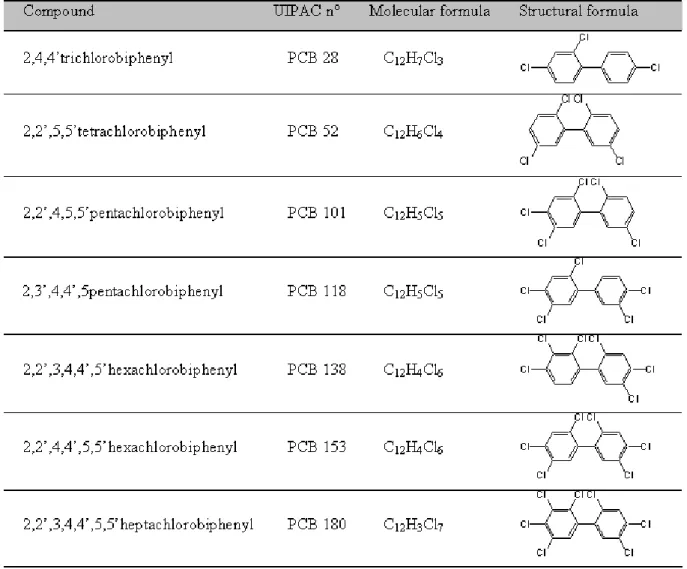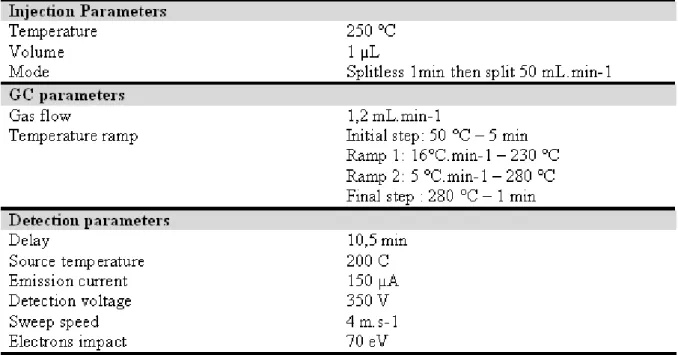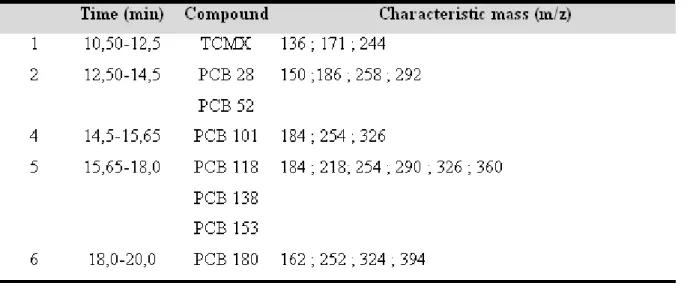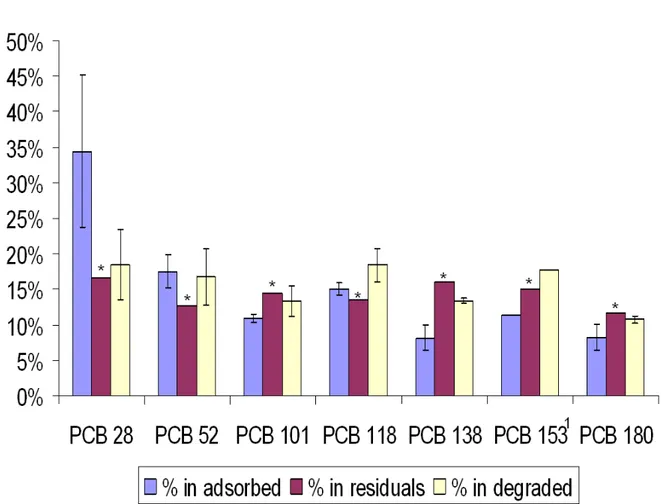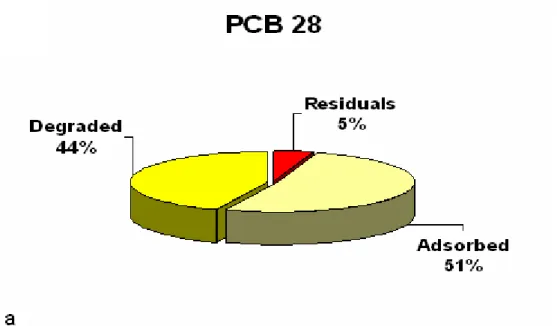Any correspondence concerning this service should be sent to the repository administrator: staff-oatao@inp-toulouse.fr
O
pen
A
rchive
T
oulouse
A
rchive
O
uverte (
OATAO
)
OATAO is an open access repository that collects the work of Toulouse researchers and makes it freely available over the web where possible.
This is an author -deposited version published in: http://oatao.univ-toulouse.fr/ Eprints ID: 3618
To link to this article: DOI:10.1080/03067310903015763 URL:
http://dx.doi.org/10.1080/03067310903015763
Sangely, Matthieu and Sablayrolles, Caroline and Vialle, Claire and Strehaiano, Pierre and Thannberger, Laurent and Vignoles, Mireille ( 2009) Polychlorinated biphenyls fractioning assessment in aqueous bioremediation assy with phanerochaete chrysosporium. International Journal of Environmental Analytical Chemistry, vol. 89 (8). pp. 849-856. ISSN 0306-7319
POLYCHLORINATED BIPHENYLS FRACTIONING ASSESSMENT IN AQUEOUS BIOREMEDIATION ASSAY WITH PHANEROCHAETE CHRYSOSPORIUM.
Matthieu SANGELYa,b,c,d Caroline SABLAYROLLESa;b, Claire VIALLEa,b, Pierre STREHAIANOc, Laurent THANNBERGERd and Mireille MONTREJAUD-VIGNOLESa,b.
a Université de Toulouse; INP; LCA (Laboratoire de Chimie
AgroIndustrielle); ENSIACET, 4 Allées Emile Monso, F-31029 Toulouse, France
b INRA; LCA (Laboratoire de Chimie AgroIndustrielle); F-31029 Toulouse
c Laboratoire de Génie Chimique, UMR CNRS 5503, 5 Rue Paulin Talabot, 31106 Toulouse,
France
Université de Toulouse, INPT, UMR 1010, F-Toulouse, France
Abstract
Thanks to growing environmental concerns in public opinion, bioremediation processes are more and more used to decontaminate soils from organic compounds. Polychlorinated biphenyls (PCBs) are known to be world wide spread persistent organic pollutants (POPs). The white rot fungus Phanerochaete chrysosporium is able to degrade PCBs in water, and soil As POPs, PCBs can also be adsorbed onto organic matter, such as Phanerochaete chrysosporium mycelium. This study aims at estimating the fractioning of truly degraded PCBs, adsorbed PCBs and residual PCBs in an aqueous bioremediation assay with Phanerochaete chrysosporium. Di-, tri- tetra-, penta-, hexa-, hepta-chlorinated biphenyls (IUPAC numbers: PCB28, PCB52, PCB101, PCB118, PCB138, PCB153, PCB180) are extracted from 500 mL aqueous bioremediation assays using a liquid-liquid extraction with n-hexane. Analyses are performed on a high resolution gas chromatography coupled with a low resolution mass spectrometry. The study reveals that the adsorbed PCBs fraction ranges from 42% to 54%, whereas the degraded one ranges from 39% to 49%. No PCBs were detected in the residual water (limit of detection: 13 ng.L-1).
Keywords: Bioremediation – Polychlorinated Biphenyl – Phanerochaete chrysosporium – adsorption.
1. Introduction
PCBs are composed of aromatic structure connected by chemical bonds [1] [2]. The general formula is C12H(10-n)Cln (Figure 1) where n is the number of chlorine atoms, from 1 to 10. The
formulae of the 7 PCBs studied are given in table 1. These molecules are chemically, physically and biologically stable and have an extremely low solubility in water especially the more chlorinated members [3]. These properties made their success in the past in heat transfer and dielectric fluids uses. These same properties make them today ones of the most watched Persistent Organic Pollutants (POPs) [4]. Moreover, they are soluble in oils and most organic solvents and have a very high environmental mobility due to their high vapor pressure [5]. Due to inconvenient storages, industrial incidents or handling oversights, PCBs have contaminated the environment. Thus, French Environment Ministry, through the BASOL database (http://basol.environnement.gouv.fr/home.htm), lists more than 240 PCBs contaminated sites. Public Authorities from Rhône river’s area have forbidden the consumption of fish caught in the Rhône river due to high levels of PCBs in fishes flesh [6]. The main destruction process for PCBs is high temperature incineration which can cause releases of highly toxic compounds like PolyChloroDibenzoDioxins (PCDDs) and PolyChloroDibenzoFurans (PCDFs). Developing alternative treatment for PCBs-contaminated soils become an environmental challenge. Biologic processes are environmental friendly and low cost. They can be a good alternative to incineration for PCBs-contaminated soil. Some microorganisms, such as Burkholderia xenovorans [7] [8] or Phanerochaete chrysosporium [9] [10] are known to degrade PCBs in presence of an additional source of carbon. Some studies report bioremediation assays but a little is known about PCBs sorption onto fungus with degradation activity like Phanerochaete chrysosporium. Consequently, this work aims to assess PCBs partition within an aqueous bioremediation assay leaded with Phanerochaete chrysosporium.
2. Materials and methods
2.1. Materials
2.1.1. Reagent:
Mineral salts K2HPO4, KH2PO4, NH4Cl, MgSO4, and CaCl2 come from Sigma-Aldrich
(Steinheim, Germany) and are at least 98 % pure. FeSO4 purity 95 % come from Prolabo
(Fontenay-sous-bois, France). A stock solution of liquid mineral medium containing K2HPO4:
4.4 g.L-1, KH2PO4: 1.7 g.L-1, NH4Cl: 2.14 g.L-1, MgSO4: 0.2 g.L-1, FeSO4: 0.01 g.L-1 and
CaCl2 : 0.003 g.L-1 is prepared [11]. Yeast extract and D(+)-Glucose-monohydrate come from
Merck (Darmstadt, Germany).
PCBs standards of di-, tri- tetra-, penta-, hexa-, hepta-chlorinated biphenyls (PCB28, PCB52, PCB101, PCB118, PCB138, PCB153, PCB180) (10 mg.L-1 in acetone) and 2,4,5,6 tetrachlorometaxylene (TCMX) are provided by Cluzeau Info Labo (200 mg.L-1 in acetone) (Sainte-Foy La Grande, France).
Extraction solvent is n-hexane suprasolv Merck (Darmstadt, Germany). Clean up is performed using 1g SPE Florisil cartridges from Supelco (Bellefonte, United States). Samples filtrations are made thanks to 11 µm-diameter filter Whatman purchased from Bioblock France (Illkrich, France).
2.1.2. Fungus strain:
Phanerochaete chrysosporium is provided by the Laboratory of Cryptogamy from the National Museum of Natural History (Paris, France), under LCP 51 995 nomenclature. Malt extract is provided by Merck (Darmstadt, Germany). Phanerochaete chrysosporium is grown in a liquid malt medium (malt extract 3 %) at 35°C on rotary shaker. Pellets are divided in 8 parts to provide inoculii.
2.2
Methods
2.2.1. Bioremediation assay
500 mL of liquid mineral medium are placed in 1 L glass erlenmeyer and sterilized by autoclaving at 120°C, under 1 bar during 25 minutes. D(+)-Glucose-monohydrate (2 g.L-1), yeast extract (0.5 g.L-1) and PCBs (10 µg.L-1 for each of the seven congeners) are sterilely added. Amended liquid mineral medium are inoculed with Phanerochaete chrysosporium as described previously. 100 mL of liquid mineral medium are taken at t=0 day. Cultures are placed at room temperature under magnetic stirring for 7 days. Experiments are led in triplicates.
2.2.2. Samples preparation and PCBs extraction
After reactions, the remaining media are filtrated through filter Whatman (pore size 11 µm) to separate the fungus from the aqueous phase.
Aqueous samples are extracted by liquid-liquid extraction with n-hexane (ratio sample:solvent = 2.5:1). A 10 minutes period of manual stirring is repeated three times. Both of organic and mineral phases are collected in the same 1 L-glass vessel and are sonicated during 5 minutes. Organic phase is dried by freezing and concentrated with rotative evaporation then under nitrogen flow to a final volume of 1 mL. The fungal organic matter is dried overnight at room temperature. Dry mycelia are separated from filters to be weighted. Both of mycelia and filters undergo a solvent extraction with n-hexane. A 10 minutes period of manual stirring is repeated three times. The organic phase is sonicated during 5 minutes. Both of residual mycelia and organic phase is frozen to separate them.
All samples are purified through a Superclean LC-Florisil SPE tube conditioned by 10 mL of hexane [12]. The extract is deposed in column head. The elution is made with 8 mL of n-hexane at 5 mL.min-1 rate. The elution product is concentrated under nitrogen flow to a final concentration of 1 mL. Fifty µL of TCMX solution (10 µg.L-1 in n-hexane) are added as
2.2.3. PCB analysis
PCBs extracts are analyzed by high resolution gas chromatography coupled with low resolution mass spectrometry (HRGC-LRMS) on electron impact mode. It is the most widely used technique for these compounds [13-17]. Ionization by this technique is the most sensitive and reproducible. The apparatus is a Thermo-Finnigan Trace 2000 series coupled with a Thermo-Finnigan Trace MS with a quadrupole type analyzer, entirely computer-controlled with data acquisition and processing using XCalibur software. The chromatograph is fitted with a Restek RTX-5MS (5% diphenyl; 95% dimethylpolysiloxane) column 30 meters long, 0.25 mm in diameter and with a 0.25 µm film thickness. Helium (Alpha 2, Air Liquide, France) carrier gas is used, flow rate 1.2 mL.min-1. A 1 µL sample is injected into the split/splitless inlet in splitless mode at 250°C. The temperature of the HRGC-LRMS interface is 250°C, and the oven temperature program starts at 50°C for 1 minute followed by a rise of 20°C.min-1 to 310°C, this temperature being maintained for 6 minutes. The full scan electron
impact data is obtained under the following conditions: solvent delay 5 minutes, electron impact energy 70 eV, source temperature 200 °C, emission current 150 µA, detector voltage 350 V.
The HRGC-LRMS temperatures ramp, injection and detection parameter are listed in table 1. Single Ion Monitoring method for detection is detailed in table 2.
3. Results and discussion
3.1. PCB analysis and degradation rate
The limit of detection (3 standard deviations) for each PCBs are 13 ng.L-1 for final aqueous samples and 150 ng.L-1 for initial aqueous samples. LOD for organic matter is 13 ng.g-1 dry
matter. The limits of quantification (10 standard deviations) are 42 ng.L-1 for final aqueous samples and 500 ng.L-1 for initial aqueous samples. LOD for organic matter is 42 ng.g-1 dry matter.
Analysis of initial aqueous sample (chromatogram shown Figure 2-a) reveals a total amount of 14.34 ± 3.45 mg PCBs. After 7 days, no PCBs were longer detectable in aqueous sample (chromatogram shown Figure 2-b) whereas 6.95 ± 2.81 mg have been quantified onto organic matter. Figure 3 presents the percentage of individual PCBs. It shows that our method does not induce selectivity toward any PCB. We can assume that the adsorption process is not influenced by numbers of atoms of chlorine.
After 7 days, the fungus have been weighted at 400 ± 115 mg of dry matter. The specific sorption rate of total PCB average 17,375 mg.g-1 DM. The average of specific sorption rate per day is 2,48 mg.g-1.d-1.
3.2. Fractioning assessment
For this calculation, LOD (42 ng.L-1) are taken for the determination of PCBs amount in final aqueous sample. Degraded PCBs are deducted according to this calculation:
Degraded PCBs = Initial PCBs – (Adsorbed PCBs + Residual PCBs)
Results, presented in table 4 , reveal that the adsorbed PCBs fraction is the main fraction with percentage ranging between 42 % and 54 %. The second fraction is the degraded one with percentage ranging from 39 % to 49 %. The residual fraction represents only 5 % to 9 % of initial PCBs content. These results indicate that despite the well-known abilities of
Phanerochaete chrysosporium to degrade organic compounds by extra cellular oxidation, a large part of them can just be adsorbed onto fungus mycelium.
These results are coherent with former studies. Ruiz-Aguilar et al. [18] show degradation rate ranging from 34 % to 73 % for 10 days incubation, on high concentration of soil extracted PCBs (from 600 mg.L-1 to 3000 mg.L-1). Nevertheless, no estimation of adsorbed fraction is made. Solvent from fungal mycelium washing phase is mixed with solvent from water extraction to form the residual fraction. Kamei et al. study [19] exhibit degradation rate about 50 % for 14 days on low concentration of 4,4′-dichlorobiphenyl (about 5 mg.L-1). Fungal mycelium is separated from liquid by centrifugation but organic matter and aqueous phase are extracted with the same solvent. No information on adsorption ability from Phanerochaete chrysosporium is shown. In an industrial process, residual and adsorbed fractions have to be handled. The sorption capacity can be used to quickly remove PCBs from water as the degradation ability could be used in long term bio treatments. Phanerochaete chrysosporium shows efficiency and wide range of degradation abilities.
These results confirm that Phanerochaete chrysosporium can degrade highly chlorinated PCBs. De et al. reported that the Nitrate reductase gene from Phanerochaete chrysosporium could be involve in dechlorination of PCB 153 under non-ligninolytic condition (nitrogen-rich condition) [9] which is the case in our study.
Besides, such calculations are useful to understand extra cellular degradation of PCBs by Phanerochaete chrysosporium. This phenomenon has to be explored to understand the degradation rate limits. Are adsorbed PCBs available to Phanerochaete chrysosporium extra cellular enzymes?
4. Conclusion
Biologic processes can be a good alternative to incineration for PCBs-contaminated soil. This study consists in assessing bioremediation of PCBs in an aqueous assay with Phanerochaete chrysosporium. Truly degraded PCBs, adsorbed PCBs and residual PCBs have been monitored. This work underlines the fact that fungus based bioremediation in aqueous media involve two phenomenon i)Biofiltration; ii)Biodegradation. After 7 days of process, an important fraction of PCBs is adsorbed onto organic matter. Further studies are led to check if a longer exposition would induce better degradated PCBs/adsorbed PCBs ratio. In case PCBs are not degraded, an aqueous PCBs bioremediation process using this fungus an additional destructive process must added to the global process to remove PCBs from fungus mycelium.
Acknowledgments
This work is supported by Agence National de la Recherche Technologique with the grant n° 46/2007 and by OSEO with the grant n°A0703011. We would like to thank Ecole National de Formation Agronomique for their technical support.
References
[1] P. Diercxsens and J. Tarradellas. Intern. J. Environ. Anal. Chem. 28, 143 (1987). [2] J. S. Waid. PCBs and the environment. CRC Press (Boca Raton, Florida, 1996).
[3] French Environment and Energy Management Agency, ADEME editions n° 1799, 223 (1996).
[4] United Nations Environment Programme, Stockholm Convention on Persistent Organic Pollutants, 2001.
[5] K. Jones and J. Stevens. Organic contaminants in sewage sludge applied to agricultural land. Water Industry Research Limited 81 (London, UK, 2002)
[6] M. Babut, C. Miege, Contamination des poisons et des sediments du Rhône par les Polychlorobiphényles – Synthèses des données disponibeles. CEMAGREF, (2007)
[7] L. Rehmann, A. J. Daugulis, Biochem. Eng. J. 38, 219 (2008).
[8] W-R. Abraham, B. Nogales, P. N Golyshin, D. H Pieper and K. N Timmis, Curr. Opin. Microbiol. 5, 246 (2002).
[9] S. De, M. Perkins and S. K. Dutta, J. Hazard. Mater. B135, 350 (2006). [10] G. V. Bhasker Reddy and M. H. Gold, Microbiol. 146, 405 (2000).
[11] D. L. Bedard, R. Unterman, L. H. Bopp, M. J. Brennan, M. L. Haberl and C. Johnson, Appl. Env. Microbiol. 51, 761 (1986).
[12] C. Sablayrolles, Ph. D. thesis, Institut National Plytechnique, 2004.
[13] G. A. O'Connor, D. Kiehl, G.A. Eiceman, and J.A. Ryan, J. Environ. Qual. 19, 113 (1990).
[14] J. F. Müller, D. W. Hawker, M. S. McLachlan, D. W. Connell, Chemosphere 43, 507 (2001).
[16] C. Bandh, E. Björklund, L. Mathiasson, C. Näf and Y. Zebühr, Env. Sci. Technol. 34, 4995 (2000).
[17] P. Kömp and M. S. Lachlan, Sci. Total Env. 63, 250 (2000).
[18] G. M. L. Ruiz-Aguilar, J. M. Fernandez-Sanchez, R. Rodriguez-Vazquez, H. Poggi-Varaldo, Adv. Env. Res. 6, 559 (2002).
Tables
Figures captions
1. Figure 1: Polychlorobiphenyls general formula.
2. Figure 2: Chromatograms from (a) initial aqueous sample, (b) final organic matter sample and (c) final aqueous sample.
3. Figure 3: Individual PCB fractioning in analysed and calculated compartments. *: Estimated with LOD.
4. Figure 4: Fractioning of trichlorobiphenyl PCB 28. 5. Figure 5: Fractioning of tetrachlorobiphenyl PCB 52.
6. Figure 6: Fractioning of pentachlorobiphenyls PCB 101 and 118. 7. Figure 7: Fractioning of hexachlorobiphenyl PCB 138 and 153. 8. Figure 8: Fractioning of heptachlorobiphenyl PCB 180.
Figures
Figure 2 : Chromatograms from (a) initial aqueous sample, (b) final organic matter sample and (c) final aqueous sample.
Figure 3 : Individual PCB fractioning in analysed and calculated compartments. *: Estimated with LOD.
